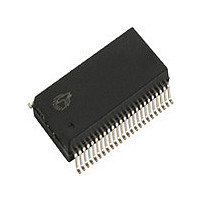CY8C3665PVI-008 Cypress Semiconductor Corp, CY8C3665PVI-008 Datasheet - Page 5

CY8C3665PVI-008
Manufacturer Part Number
CY8C3665PVI-008
Description
CY8C3665PVI-008
Manufacturer
Cypress Semiconductor Corp
Series
PSOC™ 3 CY8C36xxr
Datasheets
1.CY8C3665LTI-009.pdf
(125 pages)
2.CY8C3665PVI-008.pdf
(108 pages)
3.CY8C3665LTI-044.pdf
(126 pages)
Specifications of CY8C3665PVI-008
Core Processor
8051
Core Size
8-Bit
Speed
67MHz
Connectivity
EBI/EMI, I²C, LIN, SPI, UART/USART
Peripherals
CapSense, DMA, POR, PWM, WDT
Number Of I /o
25
Program Memory Size
32KB (32K x 8)
Program Memory Type
FLASH
Eeprom Size
1K x 8
Ram Size
4K x 8
Voltage - Supply (vcc/vdd)
1.71 V ~ 5.5 V
Data Converters
A/D 2x12b, D/A 4x8b
Oscillator Type
Internal
Operating Temperature
-40°C ~ 85°C
Package / Case
*
Operating Temperature (min)
-40C
Operating Temperature (max)
85C
Technology
CMOS
Processing Unit
Microcontroller
Operating Supply Voltage (min)
1.8V
Operating Supply Voltage (typ)
2.5/3.3/5V
Operating Supply Voltage (max)
5.5V
Package Type
SSOP
Screening Level
Industrial
Pin Count
48
Mounting
Surface Mount
Rad Hardened
No
Processor Series
CY8C36
Core
8051
Data Bus Width
32 bit
Data Ram Size
8 KB
Interface Type
I2C, SPI, UART, USB
Maximum Clock Frequency
67 MHz
Number Of Programmable I/os
28 to 72
Number Of Timers
4
Operating Supply Voltage
0.5 V to 5.5 V
Maximum Operating Temperature
+ 85 C
Mounting Style
SMD/SMT
Controller Family/series
(8051) PSOC 3
No. Of I/o's
25
Eeprom Memory Size
1KB
Ram Memory Size
4KB
Cpu Speed
67MHz
Rohs Compliant
Yes
Lead Free Status / RoHS Status
Lead free / RoHS Compliant
Lead Free Status / RoHS Status
Lead free / RoHS Compliant
The CY8C36 family supports a wide supply operating range from
1.71 to 5.5 V. This allows operation from regulated supplies such
as 1.8 ± 5%, 2.5 V ±10%, 3.3 V ± 10%, or 5.0 V ± 10%, or directly
from a wide range of battery types. In addition, it provides an
integrated high efficiency synchronous boost converter that can
power the device from supply voltages as low as 0.5 V. This
enables the device to be powered directly from a single battery
or solar cell. In addition, you can use the boost converter to
generate other voltages required by the device, such as a 3.3-V
supply for LCD glass drive. The boost’s output is available on the
V
powered from the PSoC.
PSoC supports a wide range of low-power modes. These include
a 200-nA hibernate mode with RAM retention and a 1-µA sleep
mode with RTC. In the second mode the optional 32.768-kHz
watch crystal runs continuously and maintains an accurate RTC.
Power to all major functional blocks, including the programmable
digital and analog peripherals, can be controlled independently
by firmware. This allows low-power background processing
when some peripherals are not in use. This, in turn, provides a
total device current of only 1.2 mA when the CPU is running at
6 MHz, or 0.8 mA running at 3 MHz.
The details of the PSoC power modes are covered in the
System”
Document Number: 001-53413 Rev. *K
Notes
4. This feature on select devices only. See
5. GPIOs with opamp outputs are not recommended for use with CapSense.
BOOST
pin, allowing other devices in the application to be
section on page 28 of this data sheet. PSoC uses JTAG
(OpAmp0-/Extref0, GPIO) P0[3]
(OpAmp2out, GPIO) P0[0]
(OpAmp0out, GPIO) P0[1]
Ordering Information
(OpAmp0+, GPIO) P0[2]
(OpAmp2+, GPIO) P0[4]
(OpAmp2-, GPIO) P0[5]
(IDAC0, GPIO) P0[6]
(IDAC2, GPIO) P0[7]
(GPIO) P2[3]
(GPIO) P2[4]
(GPIO) P2[5]
(GPIO) P2[6]
(GPIO) P2[7]
(SIO) P12[2]
(SIO) P12[3]
Figure 2-1. 48-pin SSOP Part Pinout
Vddio0
Vddio2
Vboost
Vddd
Vccd
Vssd
Vssb
Vbat
Ind
on page 112 for details.
10
11
12
13
14
15
16
17
18
19
20
21
22
23
24
“Power
5
8
1
2
3
4
6
7
9
Lines show
Vddio to I/O
supply
association
SSOP
(4-wire) or SWD (2-wire) interfaces for programming, debug, and
test. The 1-wire SWV may also be used for ‘printf’ style
debugging. By combining SWD and SWV, you can implement a
full debugging interface with just three pins. Using these
standard interfaces enables you to debug or program the PSoC
with a variety of hardware solutions from Cypress or third party
vendors. PSoC supports on-chip break points and 4-KB
instruction and data race memory for debug. Details of the
programming, test, and debugging interfaces are discussed in
the
page 59 of this data sheet.
2. Pinouts
The Vddio pin that supplies a particular set of pins is indicated
by the black lines drawn on the pinout diagrams in
through
support multiple interface voltage levels, eliminating the need for
off-chip level shifters. Each Vddio may sink up to 100 mA total to
its associated I/O pins and opamps. On the 68-pin and 100-pin
devices each set of Vddio associated pins may sink up to
100 mA. The 48-pin device may sink up to 100 mA total for all
Vddio0 plus Vddio2 associated I/O pins and 100 mA total for all
Vddio1 plus Vddio3 associated I/O pins.
46
45
43
37
33
32
31
29
28
48
47
44
42
41
40
39
38
36
35
34
30
27
26
25
“Programming, Debug Interfaces, Resources”
Vdda
Vssa
Vcca
P15[3] (GPIO, kHz XTAL: Xi)
P15[2] (GPIO, kHz XTAL: Xo)
P12[1] (SIO, I2C1: SDA)
P12[0] (SIO, I2C1: SCL)
Vddio3
P15[1] (GPIO, MHz XTAL: Xi)
P15[0] (GPIO, MHz XTAL: Xo)
Vccd
Vssd
Vddd
P15[7] (USBIO, D-, SWDCK)
P15[6] (USBIO, D+, SWDIO)
P1[7] (GPIO)
P1[6] (GPIO)
Vddio1
P1[5] (GPIO, nTRST)
P1[4] (GPIO, TDI)
P1[3] (GPIO, TDO, SWV)
P1[1] (GPIO, TCK, SWDCK)
P1[0] (GPIO, TMS, SWDIO)
P1[2] (GPIO, configurable XRES)
Figure
2-4. Using the Vddio pins, a single PSoC can
PSoC
[6]
[6]
®
3: CY8C36 Family
Data Sheet
Page 5 of 125
section on
Figure 2-1
[+] Feedback










